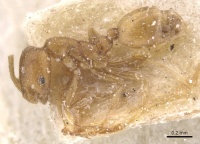Monomorium osiridis
| Monomorium osiridis | |
|---|---|

| |
| Scientific classification | |
| Kingdom: | Animalia |
| Phylum: | Arthropoda |
| Class: | Insecta |
| Order: | Hymenoptera |
| Family: | Formicidae |
| Subfamily: | Myrmicinae |
| Tribe: | Solenopsidini |
| Genus: | Monomorium |
| Species: | M. osiridis |
| Binomial name | |
| Monomorium osiridis Santschi, 1915 | |
Apparently an inhabitant of semi-open areas, this species has been found in open Miombo Woodland, Bushveld, a Combretum/Commiphora thicket, and savannah.
Identification
Bolton (1987) - A member of the M. mediocre complex in the M. salomonis species group. This small species is closely related to Monomorium zulu and Monomorium rabirium from southern Africa but tends to have slightly smaller eyes and is more strongly sculptured on the head. The fine but dense shagreenate sculpture seen on the head of osiridis contrasts strongly with the almost unsculptured appearance of zulu and rabirium, where the head retains only the faintest vestiges of superficial reticular patterning, or is smooth. Otherwise they are very similar, sharing the characters of very reduced pilosity, anteriorly shifted eyes and a lower palp formula (PF 1 ,2) than is usual in the salomonis-group (PF 2,2).
Keys including this Species
Distribution
Latitudinal Distribution Pattern
Latitudinal Range: -3.88222° to -24.93164°.
| North Temperate |
North Subtropical |
Tropical | South Subtropical |
South Temperate |
- Source: AntMaps
Distribution based on Regional Taxon Lists
Afrotropical Region: Gambia, Kenya (type locality).
Distribution based on AntMaps
Distribution based on AntWeb specimens
Check data from AntWeb
Countries Occupied
| Number of countries occupied by this species based on AntWiki Regional Taxon Lists. In general, fewer countries occupied indicates a narrower range, while more countries indicates a more widespread species. |

|
Estimated Abundance
| Relative abundance based on number of AntMaps records per species (this species within the purple bar). Fewer records (to the left) indicates a less abundant/encountered species while more records (to the right) indicates more abundant/encountered species. |

|
Biology
Castes
Nomenclature
The following information is derived from Barry Bolton's Online Catalogue of the Ants of the World.
- osiridis. Monomorium osiridis Santschi, 1915c: 258, fig. 7 (w.) KENYA.
- Type-material: holotype worker.
- Type-locality: Kenya (“Afrique orientale anglaise”): Bura, 1050 m., st. no. 61, iii.1912 (Ch. Alluaud & R. Jeannel).
- Type-depository: NHMB.
- Status as species: Emery, 1922e: 173; Wheeler, W.M. 1922a: 865; Ettershank, 1966: 91; Bolton, 1987: 354 (redescription); Bolton, 1995b: 265; Hita Garcia, et al. 2013: 213.
- Distribution: Kenya.
Unless otherwise noted the text for the remainder of this section is reported from the publication that includes the original description.
Description
Worker
Bolton (1987) - TL 1.7-1.9, HL 0.46-0.48, HW 0.34-0.38, CI 74-79, SL 0.32-0.34, SI 90-94, PW 0.22-0.24, AL 0.46-0.50 (6 measured).
Anterior margin of median portion of clypeus shallowly concave. With head in full-face view the eyes distinctly in front of the midlength of the sides and the antennal scapes, when laid straight back, failing to reach the occipital margin. Maximum diameter of eye 0.21-0.24 x HW and with 6-7 ommatidia in the longest row. Sides of head very shallowly convex and weakly convergent posteriorly behind the level of the eyes. Ocipital margin very shallowly concave. Metanotal groove represented by a transverse line across the dorsum; in profile the metanotal groove not impressed. Dorsum of head lacking standing hairs. Dorsal alitrunk without standing hairs. Petiole and postpetiole without backward directed hairs. First gastral tergite without hairs, lacking even the apical transverse row. Apical transverse row of hairs present on the second and third gastral tergites. Mandibular sculpture very feeble, effaced on the apical half of each blade. Cephalic dorsum finely shagreenate between inconspicuous shallow pits. A mid-dorsal longitudinal strip, leading back from the clypeus, is unsculptured and shining. Dorsal alitrunk reticulate-shagreenate anteriorly, the sculpture bcoming stronger posteriorly on the promesonotum; propodeal dorsum finely reticulate-punctate . Sides of alitrunk finely reticulate to weakly reticulate-punctate, with a smooth patch low down on the side of the pronotum. Petiole and postpetiole finely reticulate to granulate. First gastral tergite very weakly shagreenate basally, but this fades out posteriorly leaving the sclerite smooth and shining. Colour uniform dull yellow.
Type Material
Bolton (1987) - Holotype worker, Kenya: Bura, 1050 m, iii.1912, st. no. 61 (Alluaud & Jeannel) (Naturhistorisches Museum, Basel) [examined].
References
- Bolton, B. 1987. A review of the Solenopsis genus-group and revision of Afrotropical Monomorium Mayr (Hymenoptera: Formicidae). Bulletin of the British Museum (Natural History). Entomology. 54: 263-452. (page 326, see also)
- Santschi, F. 1915c. Nouvelles fourmis d'Afrique. Ann. Soc. Entomol. Fr. 84: 244-282 (page 258, fig. 7 worker described)
References based on Global Ant Biodiversity Informatics
- Bolton B. 1987. A review of the Solenopsis genus-group and revision of Afrotropical Monomorium Mayr (Hymenoptera: Formicidae). Bulletin of the British Museum (Natural History). Entomology 54: 263-452.
- Diame L., B. Taylor, R. Blatrix, J. F. Vayssieres, J. Y. Rey, I. Grechi, and K. Diarra. 2017. A preliminary checklist of the ant (Hymenoptera, Formicidae) fauna of Senegal. Journal of Insect Biodiversity 5(15): 1-16.
- Garcia F.H., Wiesel E. and Fischer G. 2013.The Ants of Kenya (Hymenoptera: Formicidae)Faunal Overview, First Species Checklist, Bibliography, Accounts for All Genera, and Discussion on Taxonomy and Zoogeography. Journal of East African Natural History, 101(2): 127-222
- IZIKO South Africa Museum Collection
- Wheeler W. M. 1922. Ants of the American Museum Congo expedition. A contribution to the myrmecology of Africa. VIII. A synonymic list of the ants of the Ethiopian region. Bulletin of the American Museum of Natural History 45: 711-1004

